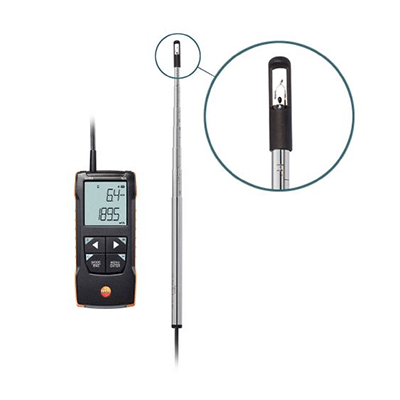What Is a Hot Wire Anemometer?

The hot wire anemometer is an instrument that measures wind velocity by using the principle that the hot wire inside the probe is cooled by the wind when the probe is exposed to wind.
Anemometers include vane anemometers and pitot anemometers, but hot wire anemometers are more suitable for indoor measurements where the temperature changes less than with other types of anemometers. The smaller probe size also allows for measurements in tight spaces.
Uses of Hot Wire Anemometer
Hot wire anemometers are primarily used indoors, such as for maintenance management of air conditioning systems and environmental evaluation of clean rooms. The probe, equipped with a sensor, is connected to the main unit by a cable and placed near air vents for measurement.
These devices often measure not only air velocity but also air volume and temperature. However, dust and debris often adhere to the hot wire, affecting the measurement, so periodic maintenance and calibration are necessary.
Principle of Hot Wire Anemometer
There are two types of hot wire anemometers: constant temperature and constant current. The constant temperature type maintains a consistent wire temperature, while the constant current type maintains a consistent current. The constant temperature type is more common due to its superior feedback control.
Hot wire anemometers use the cooling of a heated metal wire to determine wind velocity. The stronger the wind, the more the wire cools, and wind speed is determined by the relationship between wind intensity and heat dissipation. This principle is based on King’s law, stating that heat loss is proportional to the square root of wind speed.
Other Information on Hot Wire Anemometer
1. Temperature Compensation of Hot Wire Anemometer
As hot wire anemometers measure wind velocity based on temperature changes, temperature compensation is necessary to account for wind temperature variations. This is achieved by incorporating a temperature-responsive element and adjusting the heating temperature of the anemometer element in response to wind temperature changes.
2. Advantages of Hot Wire Anemometer
Hot wire anemometers are known for their fast response time due to the small size of the probe and its low heat capacity. Omni-directional probes are available for measuring wind speed without concern for the probe’s direction. However, accurate calibration is crucial for reliable measurements.
Other anemometer types include Pitot tube anemometers, which measure wind speed from the pressure difference, and vane wheel wind velocity sensors, which calculate velocity based on the number of rotations of a vane wheel. The choice of anemometer depends on the specific application requirements.